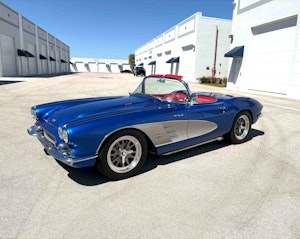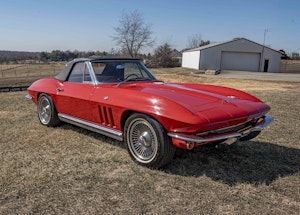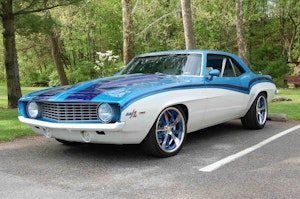Media | Articles
Leno: The Turbine Car Lives Again
When Chrysler was going bankrupt in 2009, they started selling off assets. Well, I had always wanted a 1963 Chrysler Turbine Car and when a company goes bankrupt, who do you contact? The bankers. I started calling these guys in Detroit who were handling the bankruptcy, and I asked them if they would sell me the Turbine Car from the collection. I told them I would never say how much I paid for it, but I gave them a price and the guy said, “You know, Mr. Leno, it’s not a new car. You know it’s an old car, right?” I said of course. He said, “And you want to pay that for it? Fine with me.” I still think it was a bargain compared with what it would go for today, but that’s how I was able to get it.
I drove it everywhere—to work, up Angeles Crest Highway on the weekends, everywhere. It had around 53,000 miles on it when I got it and I put on another couple thousand, and it ran OK. But I started to notice that it was running hotter. It’s supposed to run around 1200 to 1400 degrees Fahrenheit inside the engine, and then I started seeing 1425, then 1475. I learned to get on the freeway and then get off the throttle to coast, the turbine going pheeeewwwwww!, and I’d see the temperature come down, so I could keep it around 1300 by modulating it like that. Inside the engine, these two regenerators use the heat over and over again until the exhaust gas temperature is actually less than that of a piston engine—around 140 degrees coming out of the tailpipe.
What happened was, either through metal fatigue or rust, one day the regenerators just locked. The temperature shot up, 1800, 1900, then 2000 degrees. Yikes! I shut it off, coasted a bit, thought, “This is not good,” then got it going enough to make it off the freeway and we flat-bedded it back to the garage where it sat for a few years. Eventually I started calling around, figuring the car was hyped as having “So few moving parts!” that it would be easy to fix. Boy was I wrong.

Nothing is made for these cars and everything inside the engine had to be replaced. After the original 55 Turbine Cars were built, Chrysler continued to work on turbines until 1981. In fact, a good read that covers the history is Chrysler’s Turbine Car: The Rise and Fall of Detroit’s Coolest Creation by Steve Lehto (foreword by yours truly). At some point, Lehto connected me to Gregg Williams at Williams International, a turbine company in Detroit. Gregg’s late father, Sam, who founded the company, also worked on the Chrysler program, and Gregg thought it would be a fitting tribute to his dad to help me get my car going again. He offered a clean room and workers if I would pay for the parts.
Some of the engineers who worked on the program are still alive, and we had, at one point, 60 of them working on our project. Altogether it took four years, and I would get these great emails that read like, “Hi Jay, just sent you a video of a CNC lathe running a test fixture on a flame-sprayed cross-arm seal. We ran two tests that day, the one on the far right is the best so far, very promising.” They had to make the tools to make the parts, and just getting the right metal was a challenge. Because jet engines are hugely expensive to make, Chrysler wanted an alloy that was not quite good enough for aviation—where if something breaks, you fall out of the sky—but good enough for a car engine. A metallurgist from Quebec, Dr. Amedee Roy, came up with the right solution, and we had to figure out how it was made.
Marketplace
Buy and sell classics with confidence
My favorite story is about the heat exchangers in the gas regenerators, which we made new from scratch. They have 22,000 holes drilled in them, and back in 1963, one guy proposed that the holes be hexagonal rather than round as it would use the surface area more efficiently, but they didn’t have the time or technology to do it back then. Well, that guy got to see his idea implemented 60 years later.
I finally got to drive the Turbine Car again at the 2024 Woodward Dream Cruise. It’s definitely more responsive, and it runs cooler than it ever did before. As for power, it’s about the same, like a 318 V-8. But what amazes me most is that even though the car is 60 years old, when you get into it, it still feels like something out of the future.
This story first appeared in the March/April 2025 issue of Hagerty Drivers Club magazine. Join the club to receive our award-winning magazine and enjoy insider access to automotive events, discounts, roadside assistance, and more.





















I can’t believe Chrysler crushed almost all of those cars, thank god Leno was around and had the money to save one. The thing I love about Leno is he drives his cars no matter how much they are worth. Any guesses as to what that turbine car is worth? A million, maybe more?
The story has always been that Chrysler didn’t want to pay the substantial import duties on the Ghia-manufactured bodies. That was probably part of the reasoning, but providing parts (talk about unobtainium!) and service for only 50 cars was not feasible either.
Still…
Got a ride in one at a dealership in Oakland,Ca. with my Dad. The thing just soared down I 580 and seemed completely effortless. I like the styling except for the OWL eyes at the front.
Great article about a forgotten cool car!
Hot 🥵 car
Haha
Kudos to Jay Leno for saving automotive history even rebuilding it when most corporations don’t care to even save an original drawing or advertising proof.
Never got to watch Jay’s show because I had an early morning job, but I have learned a high respect for him because of his car hobby and the videos he makes. I did go see him at a live performance in 2016.. he was great !
As a kid at my grandfathers gas station, I remember one pulling in to fill up.The owner opened the hood so I could check the oil. He then asked my grandfather and I “where do you check the oil level?”. I pointed to the only dipstick I saw, and my grandfather said “no, that is for the transmission”. Turns out I was correct, they shared the oil.
I’ve never forgotten that car!
Jay Leno is the patron saint of gearheads. *sheds tear 🙂
My favorite part of the story is the guy with the idea of the hexagonal holes getting to see his 60 year old idea implemented. I wonder how. Was it additive manufacturing? That would make sense.
My guess is laser cutting- cheap and accurate. Depends on the part thickness, though.
I was actually lucky enough to get to drive one of these babies back in the mid-1960’s. I was still in HS at the time and had just gotten my DL. Luckily, a school chum’s next-door neighbor was the local Chrysler rep. At that the time, the factory reps were the only people issued these turbine cars – and on a rotating basis. So, with the rep in the car, he allowed me, school chum, and his son (we all had just gotten our DL’s) to take short runs in the car. It was very different – compared to what we were used to at the time. It was a great one-shot deal we would never forget.
And then, in 1975, while visiting Cape Kennedy (so named at the time) in FL, when they used to let you practically have the run of the place, Chrysler was pushing its next version of the car – an Imperial – with some of the leftover turbines from the decade before. What a shocker! Turbine worked great. The Lead Sled Imperial – not so much .
I have seen a few in museums and back in the day, I saw one driving through Fairfield center in Connecticut. Most of them in the museums didn’t have the engine. Jay is lucky to have a running one.
…built this as a model in my youth… still love that colour, the styling and the whole aura around that car…. thanks Jay!
I built a Jo-Han model of this, super detailed. Cool car.
I’m happy to see it on the road. It may be an automotive footnote but what an idea.
I have always liked the design and idea of the turbine car. Being a T56/501 turbo-prop mechanic I’ve always wondered where the exhaust is. Would have thought straight up, but there are no vents visible in the overhead photo. I wouldn’t think rear or side due to heat and velocity, so out the bottom? But then noise would be a factor as well as cooking the asphalt!
Why didn’t they build one or two for the NASCAR circuit? Isn’t that the ultimate test track? Still not too late for Mopar to do thais, we know that NASCAR banned the Mopar hemi’s! So much for progress!